INSIGHTS: How to Choose the Best Dive Compressor for your Boat
When planning their sailing and liveaboard lifestyle, Polish cruisers Aleksandra and Tomek knew from the very beginning that they wanted to combine sailing with diving, which has been their passion for many years. So they decided to investigate having a dive compressor on board to give them their own diving independence.
Published 5 months ago
Combining a Sailing and Diving Lifestyle
Before we bought the boat, we did a lot of diving with diving schools and used to go on liveaboards. About one of them in Sudan, you can read about here. It has always been organized diving, but with plans for our sailing in mind, we have long been trying to become as independent underwater as possible.
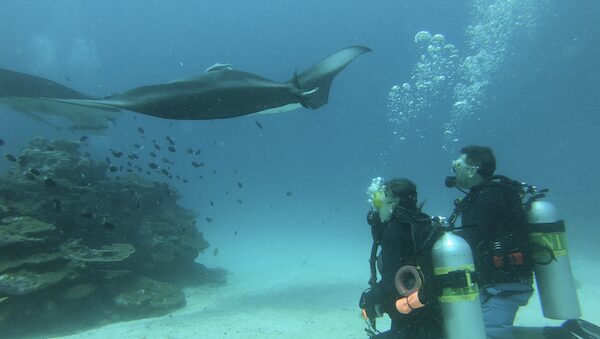

Diving independence
For us, a huge step towards independence in diving was the purchase of a dive compressor. While looking for a boat, we considered whether there would be room to install a compressor on a given yacht model. However, we waited until the second season on the boat to implement this plan.
We knew that we would spend most of our first season in cold waters (Baltic Sea, North Sea and Atlantic), where we did not plan to dive. And of course we had other aspects to worry about, related to the beginning of the adventure and the new yacht, so diving had to wait. But when we reached the Balearic Islands, we started diving anyway! And from that moment on, we would probably dive more, but the lack of a compressor got in the way.
Is dive compressor really needed?
When planning diving from a yacht, we often heard advice that a compressor is not needed and that the tanks can be filled at diving centers along the way. This is probably true, provided you dive occasionally. However, planning to dive regularly and frequently, we strongly disagree with this.
Filling the tanks in diving centers is problematic. You have to find such a place, sail there, carry heavy tanks across the town and then ask for them to be filled. Many diving centers do not have this service as standard. Countries often have different regulations regarding cylinder inspections. It happened to us that on one island the diving base filled our tanks without any problems, while the other one, referring to the national regulations that differed from the EU’s, did not.
Moreover, we hope to dive in places where the diving infrastructure is really far away, so for us the only solution was to have a diving compressor on board.
Choosing a dive compressor
We started looking for a diving compressor even before we bought the yacht. We discussed for a long time and analyzed which one would be best for us. There are two large manufacturers of small portable compressors for applications such as ours. However, they differ in drive, parameters, size and, of course, price.
So we decided to share with you our experience in choosing a compressor. In this article you will read what dive compressors are available on the market and what parameters to pay attention to. At the end you will find a table comparing the most popular models that we took into account.
Electric or petrol dive compressor?
The first question we had to answer was whether we were buying a compressor with a petrol or electric engine. Both have pros and cons.
Electric dive compressor
Advantages of electric dive compressors
Electric compressors are smaller and can be installed under the deck without the need to add an exhaust or run an air intake hose outside. They are more quiet than compressors with petrol engines. They are easier to operate because they do not have an additional petrol engine. There is no need to carry extra fuel with you.
Assuming that we have an electrical system and power source that can cover the electrical demand of such a compressor, this is a good solution. So what are its disadvantages?
Disadvantages of electric dive compressors
Some electrical devices, such as a compressor, have a starting peak in power consumption. To satisfy it, you need a generator with a power of at least 8 kW. In our electrical system, we have a 3.5 kW inverter, which would be sufficient to operate the compressor, but not to cover this peak during startup. An alternative solution is adding another inverter with the so-called “soft start”. Since this is a major interference in the electrical system and the addition of a three-phase installation to the boat’s system, we wanted to avoid it.
Even though we are currently completely self-sufficient electrically, operating a compressor a few times a day would pose a heavy load on our installation. On long, sunny days like today in the Mediterranean, this would not be a problem. But in tropical regions where the sky is often cloudy, we could start to experience some power shortages.
However, the final decision regarding the compressor drive was made when it turned out that even a small electric compressor would not fit into our locker – by about 2 cm. The only compressor with appropriate dimensions was the American brand Mantus, but we gave up on it based on its parameters, which I will write about in a moment.
Petrol dive compressors
After a very long brainstorming and various plans to modify the boat, we gave up. And since there was no room to install the compressor under the deck or in the lockers, it had to be installed on the deck. We knew from the beginning that this was not a perfect solution and we still think so. Nevertheless, it’s a compromise and I think it worked out quite well for us!
Since we decided to install a compressor on board, petrol compressors came into play. Thanks to it, we were able to avoid modifying the electrical system. Additionally, we would not be dependent on the weather and, consequently, on the amount of electricity produced. The disadvantages of such a compressor are certainly noisier operation and additional petrol engine maintenance – changing oil, filters, etc. There is also the need to store a supply of gasoline. After considering the pros and cons, we decided to choose a petrol compressor
Dive compressor manufacturers
Coltri and Bauer dive compressors
There are two main compressor manufacturers on the market – Bauer and Coltri. We relied on the experience of other cruisers who had dive compressors on board. We checked reviews, parameters, dimensions, availability and prices. On this basis, we selected the models we were interested in and compared their data.
Mantus dive compressor
In addition to the manufacturers listed above, there is also a Mantus compressor on the market. The Mantus company deals with yacht equipment and also offers a dive compressor. However, we gave up on this compressor quite quickly, even though we liked its small size. The problem was the very low air flow during filling, which was three times lower than other compressors we considered – 35l/min. This would significantly extend the time it takes to fill the cylinder.
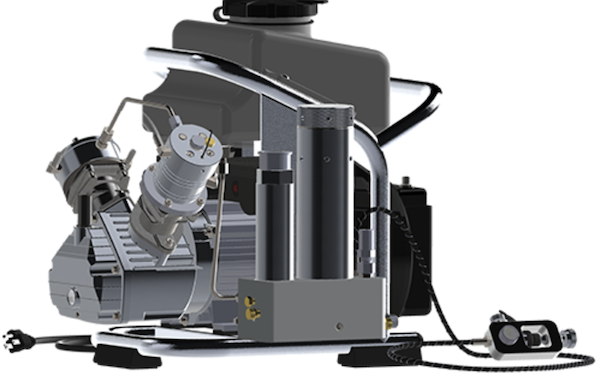

Mantus offers very small 3.5-liter diving cylinders as well. It seems that this compressor is designed for just such applications. Such a setup will be useful when cleaning the bottom, for short underwater works and shallow immersions of a few meters. When diving regularly with full-size tanks, its efficiency is simply too low.
Another problem was its availability. When sending an inquiry to the representative in Greece in September, the expected delivery was for mid-April next year. Of course, express delivery was also an option, within 2 to 3 weeks. However, the price of such a service is 600€, which is almost 25% of the price of the compressor. After eliminating Mantus, we were left to consider two models of Bauer compressors and a compressor from the Italian company Coltri.
Bauer dive compressors
Bauer offers two portable compressors. These are Junior II and Oceanus. Both are available with electric motors (1- and 3-phase) and a petrol engine.
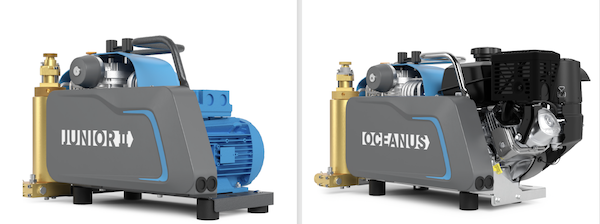

In the case of the version with an electric motor, the manufacturer additionally offers the “Yacht Package”, which includes additional protection of the electrical system against external conditions (NEMA 4), automatic condensate drain with muffler/separator + condensate reservoir and stainless steel fittings. Unfortunately, this additional equipment increases the dimensions of the entire compressor. We won’t compare every possible option here, because there are quite a few of them. Electric versions were eliminated for the reasons I wrote above (the need to modify the installation and the efficiency of the system). The parameters of the compressor itself, regardless of whether it is driven electrically or by a petrol engine, do not differ, and the detailed data can be found in the table at the end of this post.
Bauer Oceanus dive compressor
So let’s start with the Oceanus model, which is dedicated to use on boats. The parameters of this model are very high. The air flow is 139 l/min, which allows you to fill a 12-ltr diving cylinder in 14 minutes. The dimensions of the compressor are 787 mm x 356 mm x 432 mm. It is equipped with a durable oil pump. Large oil sump allows shipboard inclination of up to 30 degrees (20 degrees in the case of a petrol-driven compressor). The coolers are made of non-corrosive materials and the entire frame is made of stainless steel. This is definitely the best model from Bauer for use on a yacht. However, it has one big disadvantage – the price. The Oceanus model costs approximately 8000€.
Bauer Junior II dive compressor
For comparison, I will describe here the second model of the portable Bauer compressor – Junior II. It is slightly smaller than Oceanus – 762mm x 356mm x 432mm. The air flow in this model is 122 l/min and the operating pressure is 345 bar. These are also very good parameters. Unfortunately, we do not have a stainless steel frame as standard, which is necessary if we want to mount the compressor on board in wet and salty conditions. Additionally, this model does not have any modifications to the oil lubrication system, which would make it possible to fill the cylinders on a rolling yacht. Although the Junior II model has very good parameters and is a portable compressor with small dimensions, in our opinion it is not an ideal solution for a yacht.
Coltri dive compressors
The second manufacturer we considered was the Italian company Coltri. In the United States, MaxAir compressors are manufactured under their license.
Coltri Mini Compact and Coltri Icon lines
Coltri has two lines of portable compressors – Icon and Mini Compact. Models from these lines are available in both electric and petrol versions. You can also choose air flow – from 50 to 100 l/min and other additional equipment.
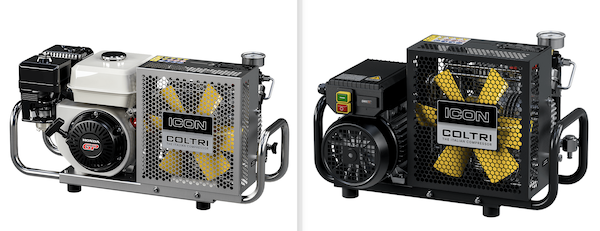

The Mini Compact Petrol model was defeated initially by its dimensions, which are not “mini” at all – 80 cm x 37 cm x 44 cm. The Icon line looks a bit better with dimensions of 79 cm x 37 cm x 39 cm because it is not enclosed in a cage like the Mini model. We can choose between the basic Icon model and Icon Inox – with a stainless steel frame. This version is equipped with a 5.7-horsepower Honda GP 200 engine. In the basic version (without a stainless steel frame), an optional smaller Kohler 265 engine is available.
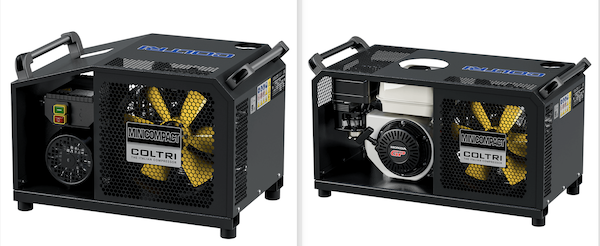

When ordering, we also choose the operating pressure – 232 or 300 bar. For recreational diving we choose 232 bar. This is very important because at 300 bar the cylinder connections will not fit! The Icon Inox Petrol version has an air flow of 100 l/min. This is less than Bauer compressors, but still allows you to fill a standard 12-liter diving tank in 20 minutes.
Older models of Coltri compressors had problems with the compressor lubrication system. This has been modified in the new model by enlarging the oil tank and we hope this problem is solved. This was confirmed by the compressor service, which had a large number of repairs for the old model, while none for the new one, so far.
After many analyses, a fraction of which you read here, we were faced with a choice between two models – Bauer Oceanus and Coltri Icon, both with petrol engines.
Bauer vs Coltri dive compressors
After a thorough analysis of the parameters and other factors, the winner was Coltri Icon Inox with petrol engine, which is currently mounted on our deck and serves us well. What made you choose this company?
- shorter in dimension than Bauer compressor. By mounting the compressor on board, we wanted to limit the field of view as little as possible;
- delivery time – it was available much faster than Bauer;
- the price of a Coltri compressor is approximately 40% of the price of a Bauer compressor.
How the Bauer Oceanus is better than Coltri?
- the time to fill the cylinder in the case of Bauer would be about 14 minutes, not 20 as in the case of Coltri;
- lubrication system allowing operation at a tilt of 30 degrees (our Coltri has a 6-degree limit).
- better user reviews.
Additional equipment
Each of the compressors described above can be ordered with additional equipment. These include automatic condensate drain, automatic shutdown switch, longer hoses and much more, depending on the manufacturer.
What we think is worth ordering is a longer hose for filling the cylinder. Thanks to this solution, our cylinders remain in the shaded cockpit while we fill them. We also don’t have to carry them near the compressor on board.
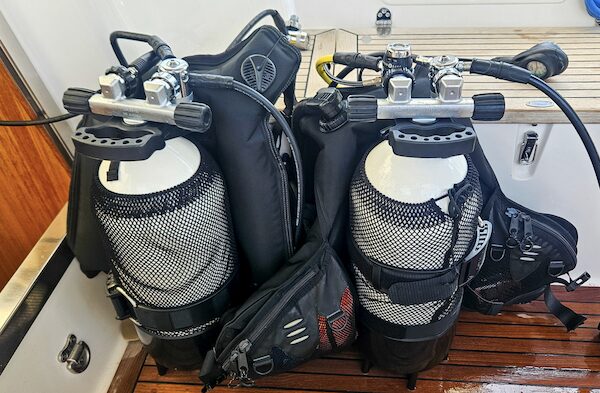

Additionally, we ordered an extended air intake hose. If you have a petrol compressor, for safety reasons, we recommend moving air intake as far as possible upwind from potential exhaust gasses. We pull our 3-meter hose on the spinnaker halyard upwards and always into the wind.
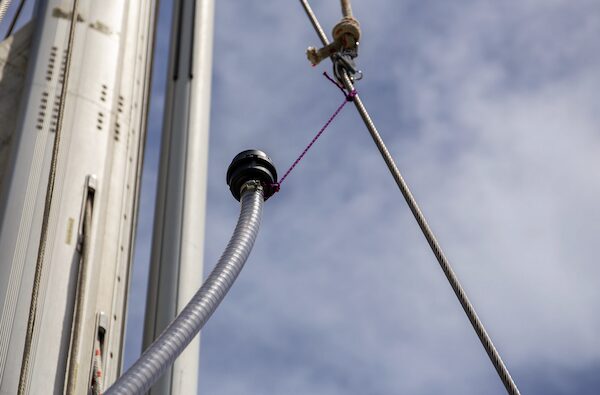

Another thing worth considering is an additional valve on the filling hose, which can significantly improve work when changing cylinders.
We did not decide on an automatic condensate drain. Although this is certainly a very convenient solution, in our opinion the cost of this equipment is too high – 650€. Currently, we drain the condensate ourselves every 7 minutes of compressor operation, i.e. once while filling the cylinder and after each filling. Automatic shut down of the compressor would cost us another 620€, so we turn off the compressor ourselves
Dive compressor models comparison
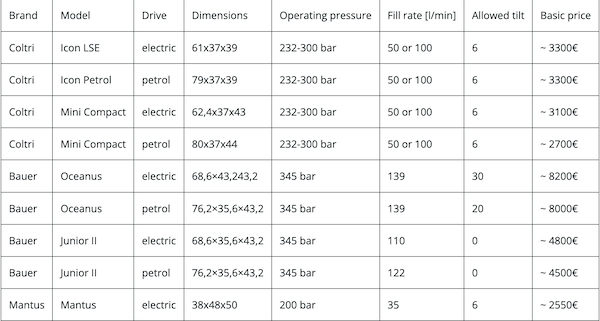

Summary
Another solutions of dive compressors
To summarize, there are two main companies offering portable dive compressors on the market that in our opinion are worth considering. Additionally, you can find alternative solutions. One of them is a compressor driven directly from the yacht’s engine shaft. Another solution are devices floating on the surface that constantly pump air directly to the diver using a long hose. I also came across very cheap compressors from China. However, we did not consider these options because we plan to dive a lot and regularly. We were looking for a long-term, durable solution that would not limit our diving and would be safe.
Our experience with Coltri Icon
We are currently in the first season of using a dive compressor on board. We built it in a waterproof box, which serves its purpose very well.
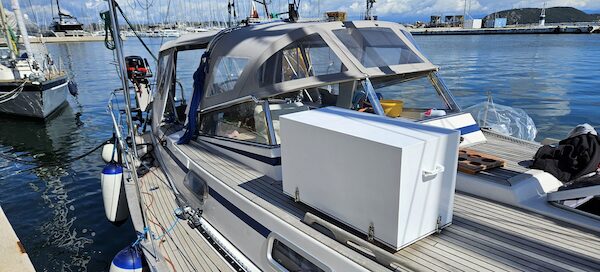

At the moment, we are satisfied with the choice of the petrol compressor. Being independent of the electricity generated, we can use it without limits. When we dive a lot, we fill four tanks a day, sometimes six and it is not a problem. The noise level is about 100 dB, so we operate the compressor with earmuffs, but it is no louder below deck than when the engine is running.
We hope that you found interesting information in this article. If you are planning to purchase a diving compressor for a yacht, do not hesitate to contact us. There are many other aspects to consider when choosing one that we have not covered here.
In the meantime, we hope to dive even more and provide you with lots of diving content! So far, you can check on some our diving videos here.
………………………
About the Authors:
Before casting off the docklines as live-aboard cruisers, Polish couple Aleksandra and Tomek had been working as airline pilots in the Middle East. The dream to sail the world came to their minds several years ago and because they loved sailing, diving, hiking and the outdoors, living full-time on a sailboat looked like the perfect opportunity to connect all their hobbies.
After an 18 month search they bought “Tranquility” in Sweden, a Malo 39 and in March 2023 set off on their adventure to sail the world. After crossing the Baltic Sea from Sweden to Poland where they did some upgrades to “Tranquility”, they headed for the Mediterranean and Greece where they plan to spend the rest of 2024.
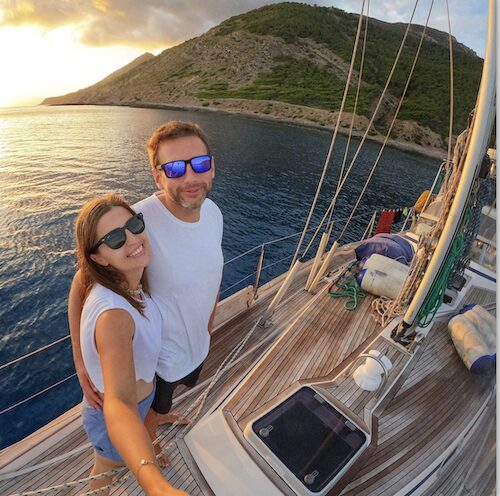

Follow Aleksandra and Tomek’s journey at Tranquility Mare
……………………..
The opinions expressed in this article are the author’s own and do not reflect the view of Noonsite.com or World Cruising Club.
………………………
Find out all news, reports, links and comments posted on Noonsite, plus cruising information from around the world, by subscribing to our FREE monthly newsletter. Go to https://www.noonsite.com/newsletter/.
Related to the following Cruising Resources: Cruising Information, Equipment, General, Insights, Liveaboard Tips, Planning and Preparation





In this video he shows how to wire a soft start for your compressor without modifying the inverter/electrical system. Has anyone gone this route with a modest inverter and made it work?
https://youtu.be/VoKSq631JAc?si=qEiOtE1QMzGUG4aW